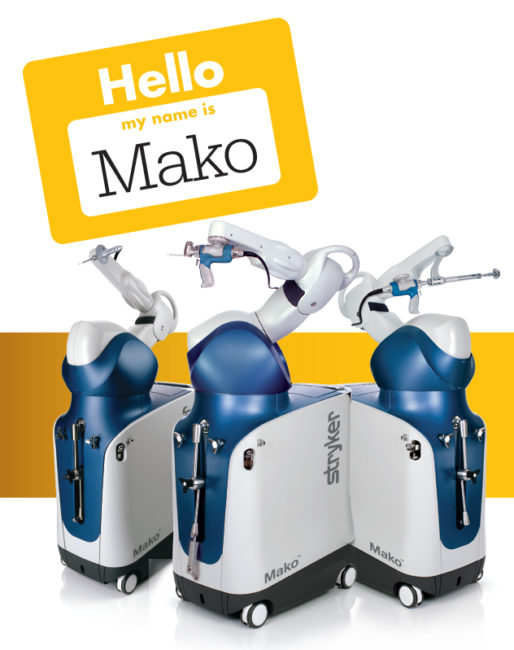Samaritan Medical Center Now Offering Advanced Robotic-Arm-Assisted Joint Replacement with Stryker’s Mako SmartRobotics™ System
Published on: June 18, 2021
Innovative robotic technology allows orthopedic surgeons to personalize total knee, partial knee and total hip replacement procedures to each patient in the North Country
Watertown, NY – Samaritan Medical Center is the first hospital in the region to offer robotic-assisted joint replacement with the Mako SmartRobotics™ system. This advancement in joint replacement surgery transforms the way total knee, partial knee and total hip replacements are performed, by helping our surgeons know more and minimize incisions.

Mako SmartRobotics™ combines three key components – 3D CT-based planning, AccuStop™ haptic technology and insightful data analytics – into one platform that has shown better outcomes for total knee, total hip and partial knee patients.6-8
“With Mako SmartRobotics™, I know more about my orthopedic patients than ever before, and I’m able to make more calculated incisions,” said Dr. David Newman of Samaritan Orthopedics. “For some patients, this can mean less soft tissue damage3,4; for others, greater bone preservation.2,5 Mako’s 3D CT allows me to create a personalized plan based on each patient’s unique anatomy before entering the operating room. During surgery, I can validate that plan and make any necessary adjustments while guiding the robotic arm as I execute that plan. It’s exciting to be able to offer this transformative technology for patients that need a total knee, total hip and partial knee replacements.”
“We recently performed our first robotic-assisted orthopedic surgery at Samaritan and it went very well,” said Dr. Newman. “I am pleased to offer more local patients this option as we help them alleviate their pain. We already have several patients seeking this advanced surgical option.”
Total knee replacements in the United States are expected to increase 189% by 2030,9 yet studies have shown that approximately 20% of patients are dissatisfied after conventional surgery.10 Mako Total Knee combines Stryker’s advanced robotic technology with its clinically successful Triathlon Total Knee System, which enables surgeons to have a more predictable surgical experience with increased precision and accuracy.11 In clinical studies, Mako Total Knee demonstrated the potential for patients to experience less pain, less need for opiate analgesics, less need for inpatient physical therapy, reduction in length of hospital stay, improved knee flexion and greater soft tissue protection in comparison to manual techniques.3,7
Mako SmartRobotics™ for Partial Knee replacement is a treatment option designed to relieve the pain caused by joint degeneration due to osteoarthritis that has not yet progressed to all three compartments of the knee. In surgery, the surgeon guides the robotic arm during bone preparation to execute the predetermined surgical plan and position the implant. By selectively targeting only the part of the knee damaged by osteoarthritis, surgeons can resurface the diseased portion of the knee while helping to protect the healthy bone surrounding the knee joint.4 Studies have shown that robotic-arm assisted partial knee replacement, leads to greater accuracy of implant position to plan compared to manual partial knee replacement procedures.12,13
By 2030, total hip replacements in the United States are projected to grow 171%.9 Mako SmartRobotics™ for Total Hip is a treatment option for adults who suffer from degenerative joint disease of the hip. In surgery, the surgeon guides the robotic arm during bone preparation to prepare the hip socket and position the implant according to the predetermined surgical plan. In a controlled matched-paired study to measure acetabular bone resection, results suggested greater bone preservation for Mako Total Hip compared to manual surgery.2
“We are proud to be the first hospital in our area to offer this highly advanced SmartRobotics™ technology,” said Tom Carman, President and CEO of Samaritan Medical Center. “This addition to our orthopedic service line further demonstrates our commitment to provide the community with outstanding healthcare. This SmartRobotics™ system is the third major robotics platform we have invested in for our patients and surgeons.”
Learn more about the SmartRobotics™ system and what it offers at samaritanhealth.com/orthorobotics.
###
IMPORTANT INFORMATION
Knee and hip replacement is intended for use in individuals with joint disease resulting from degenerative and rheumatoid arthritis, avascular necrosis, fracture of the neck of the femur or functional deformity of the hip.
Knee joint replacement is intended for use in individuals with joint disease resulting from degenerative, rheumatoid and post- traumatic arthritis, and for moderate deformity of the knee.
Joint replacement surgery is not appropriate for patients with certain types of infections, any mental or neuromuscular disorder which would create an unacceptable risk of prosthesis instability, prosthesis fixation failure or complications in postoperative care, compromised bone stock, skeletal immaturity, severe instability of the joint, or excessive body weight.
Like any surgery, joint replacement surgery has serious risks which include, but are not limited to, pain, infection, bone fracture, change in the treated leg length (hip), joint stiffness, hip joint fusion, amputation, peripheral neuropathies (nerve damage), circulatory compromise (including deep vein thrombosis (blood clots in the legs)), genitourinary disorders (including kidney failure), gastrointestinal disorders (including paralytic ileus (loss of intestinal digestive movement)), vascular disorders (including thrombus (blood clots), blood loss, or changes in blood pressure or heart rhythm), bronchopulmonary disorders (including emboli, stroke or pneumonia), heart attack, and death.
Implant related risks which may lead to a revision of the implant include dislocation, loosening, fracture, nerve damage, heterotopic bone formation (abnormal bone growth in tissue), wear of the implant, metal and/or foreign body sensitivity, soft tissue imbalance, osteolysis (localized progressive bone loss), audible sounds during motion, reaction to particle debris , and reaction to metal ions (ALTR). Knee and hip implants may not provide the same feel or performance characteristics experienced with a normal healthy joint.
The information presented is for educational purposes only. Speak to your doctor to decide if joint replacement surgery is appropriate for you. Individual results vary and not all patients will return to the same activity level. The lifetime of any joint replacement is limited and depends on several factors like patient weight and activity level. Your doctor will counsel you about strategies to potentially prolong the lifetime of the device, including avoiding high-impact activities, such as running, as well as maintaining a healthy weight. It is important to closely follow your doctor’s instructions regarding post-surgery activity, treatment and follow-up care. Ask your doctor if a joint replacement is right for you.
Stryker Corporation or its other divisions or other corporate affiliated entities own, use or have applied for the following trademarks or service marks: AccuStop, Mako, SmartRobotics, Stryker, Triathlon. All other trademarks are trademarks of their respective owners.
REFERENCES
- Bell SW, Anthony I, Jones B, MacLean A, Rowe P, Blyth M. Improved accuracy of component positioning with robotic-assisted unicompartmental knee arthroplasty: data from a prospective, randomized controlled study. J Bone Joint Surg Am. 2016;98(8):627-635. doi:10.2106/JBJS.15.00664
- Illgen RL, Bukowski BR, Abiola R, et al. Robotic-assisted total hip arthroplasty: outcomes at minimum two year follow up. Surg Technol Int. 2017;30:365-372.
- Mahoney O, Kinsey T, Mont M, Hozack W, Orozco F, Chen A. Can computer generated 3D bone models improve the accuracy of total knee component placement compared to manual instrumentation? A prospective multi-center evaluation. Poster presented at: 32nd Annual Congress of the International Society for Technology in Arthroplasty; October 2-5, 2019; Toronto, Canada.
- Suarez-Ahedo C, Gui C, Martin TJ, Chandrasekaran S, Lodhia P, Domb BG. Robotic-arm assisted total hip arthroplasty results in smaller acetabular cup size in relation to the femoral head size: a matched-pair controlled study. Hip Int. 2017;27(2):147-152. doi:10.5301/hipint.5000418
- Kayani B, Konan S, Pietrzak JRT, Haddad FS. Iatrogenic bone and soft tissue trauma in robotic-arm assisted total knee arthroplasty compared with conventional jig-based total knee arthroplasty: a prospective cohort study and validation of a new classification system. J Arthroplasty. 2018;33(8):2496-2501. doi:10.1016/j.arth.2018.03.042
- Hozack WJ. Multicentre analysis of outcomes after robotic-arm assisted total knee arthroplasty. Bone Joint J:Orthop Proc. 2018;100-B(Supp_12):38.
- Banks SA. Haptic robotics enable a systems approach to design of a minimally invasive modular knee arthroplasty. Am J Orthop (Belle Mead NJ0. 2009;38(2 Suppl):23-27.
- Hampp E, Chang TC, Pearle A. Robotic partial knee arthroplasty demonstrated greater bone preservation compared to robotic total knee arthroplasty. Poster presented at: Orthopaedic Research Society Annual Meeting; February 2-5, 2019; Austin, TX.
- Piazza S. Designed to maintain collateral ligament stability throughout the range of motion. Stryker-Initiated Dynamic Computer Simulations of Passive ROM and Oxford Rig Test. 2003.
- Wang H, Simpson KJ, Ferrara MS, Chamnongkich S, Kinsey T, Mahoney OM. Biomechanical differences exhibited during sit-to-stand between total knee arthroplasty designs of varying radii. J Arthroplasty. 2006;21(8):1193-1199. doi:10.1016/j.arth.2006.02.172
- Gómez-Barrena E, Fernandez-García C, Fernandez-Bravo A, Cutillas-Ruiz R, Bermejo-Fernandez G. Functional performance with a single-radius femoral design total knee arthroplasty. Clin Orthop Relat Res. 2010;468(5):1214-1220. doi:10.1007/s11999-009-1190-2

